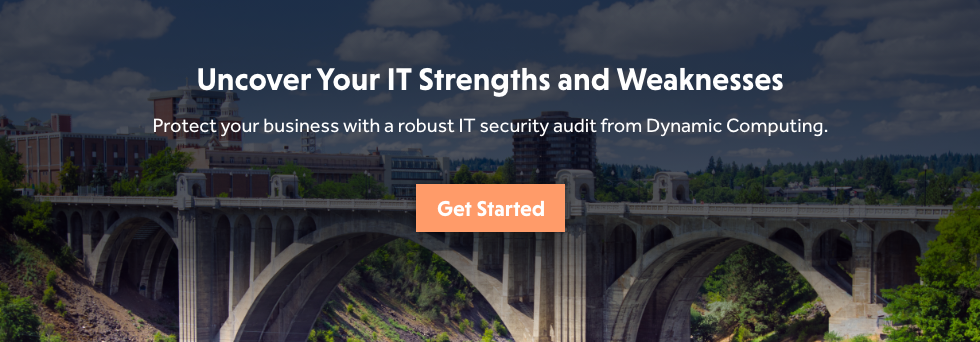From financial records to client information to valuable IP, your IT systems house highly confidential information that are crucial to your business operations. Protecting those assets is central to protecting your business.
An IT security audit provides an in-depth evaluation of your business’s current IT measures in the context of an end-to-end IT audit. It includes a professional evaluation of your physical infrastructure, software platforms, user roles, and more. After all, you can’t find all the holes if you don’t inspect the entire property.
The Risk Is Too Big Not To Use an Expert
IT security experts know exactly what to look for, which questions to ask, and how to implement simple safeguards that offer true protection. They start with a vulnerability assessment to identify low-hanging fruit – like out-of-date software, weak password policies, or insufficient firewalls – and grab easy wins. Then they create a game plan for the bigger, more complex tasks.
In a world of constant change and evolving threats, it’s hard to know exactly what you need to safeguard against the unknown. It’s just too big of a risk to put your head in the sand or pretend you can manage IT security on your own.
Everyone Is Vulnerable, So Get That Assessment
Cyber-attacks don’t just happen to big names like Sony, Equifax, or Yahoo. They impact small and mid-sized businesses as well, and they can be detrimental to your company’s goals, operations, and bottom line.
An IT vulnerability assessment shows you exactly where your business stands. It gives you the information to strategize and scale without sacrificing security. From there, you can build an action plan to keep your business on top.
Your Reputation Is on the Line
Cyber-attacks carry major consequences and disruption. For businesses in legal, medical, and financial fields, compromised IT security carries major legal ramifications and impacts licensing and certification statuses.
Other companies, like those in architecture and real estate, hold a trove of information on their clients’ floor plans, access points, and building security systems, leaving them responsible for protecting that information against nefarious actors.
Regardless of the intent of the attack, the aftereffects will have a lasting impact on your business. Cleanup generally requires network downtime, resulting in disrupted productivity and even data loss if adequate backups aren’t in place. Depending on the industry and impact, you may even have to divert funds and attention to PR campaigns, regulatory fines, and investigations.
An IT security audit can help you prevent that disruption from ever happening. An audit is far more than a CYA measure – it’s a strategic move to protect your investments.
What Happens During an IT Security Audit
An audit should be seen as part of the big-picture IT plan for your business. Audits identify and implement multiple industry standard systems and protocols that keep you a step ahead of the next threat.
Here are a few of the items that an audit tackles:
- Email. The weakest link in your IT security is often the employee who accidently clicks on a bad link in the wrong email. Phishing attacks are the most common security incidents in small to mid-sized businesses. Prevention includes using spam filters, link and attachment scanning, centrally managed endpoint protection software, and a dual approach to web content filtering.
- Credentials. Weak or compromised credentials are a hacker’s gold mine. To avoid giving bad actors easy access to your business operations, be sure to require two-factor authentication on all your company accounts. This adds an extra layer of security for employee X that uses “Password123” on every account.
- Theft protection. A good old-fashioned smash-and-grab can be just as problematic as a sophisticated cyber-attack, but there are a few steps you can take to protect yourself in case your computer falls into the wrong hands. Enable drive encryption on your laptop, implement centralized device monitoring with your IT team, and apply STOP plates (a special anti-theft sticker) to any computers that are deployed in common areas where an increased risk of theft is inherent.
- Shadow IT. Everybody has their favorite collaboration tools. Simple things like messaging, file sharing, and task management can take place on an endless variety of personal platforms and devices outside of your IT team’s purview. This creates shadow IT, and it leaves your business and your employees’ work vulnerable to security breaches. Countering this requires strategic leadership from your IT team. It’s all about asking the right questions, empowering employees with the right tools, and setting IT standards.
You Want a Partner, Not Just a Provider
IT security is a major player in your IT strategy. An audit will give you a clear understanding of where your cyber security stands and just how strong your foundation is. The next step is to choose an IT managed service that will work with as a partner to provide the tools, techniques, and training needed to keep your business safe, secure, and compliant all at the same time.
They will work with you to monitor networks and identify suspicious activity before it ever becomes a threat. They’ll help you develop protocols and educate your teams on IT security best practices. Then, as you continue to plot the trajectory of your business, they help you select digital systems that both empower your work and protect your data.
You’re Not in IT Alone
You want to avoid IT service providers that fail to conduce a comprehensive assessment and instead provide recommendations using quick and canned one-size-fits-all approaches. Find a provider that will really dig into your unique workflows, all your IT tools, and your business objectives, then put your operations under a microscope to root out the weak spots. Only after that can they deliver recommendations that will fit your business.


